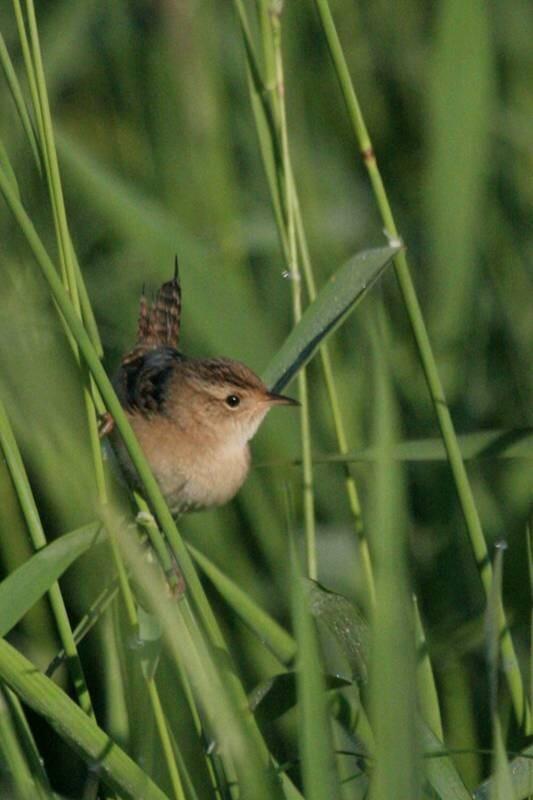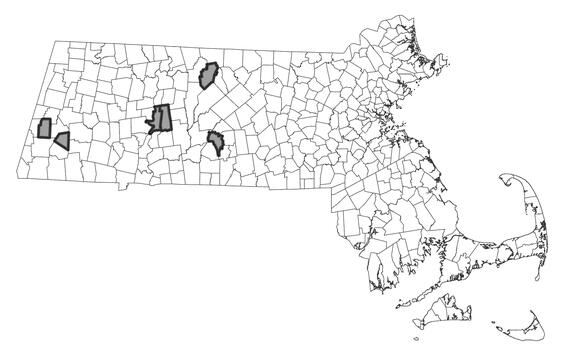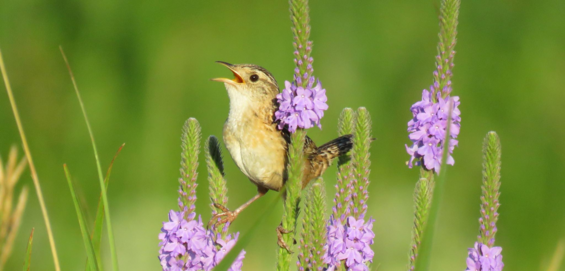- Scientific name: Cistothorus platensis
- Species of Greatest Conservation Need (MA State Wildlife Action Plan)
- Endangered (MA Endangered Species Act)
Description

Sedge wren in wetland grasses.
The sedge wren is a small, secretive passerine bird that inhabits shallow wetlands dominated by short grasses and sedges. Sedge wrens have both short tails and short bills and are approximately 11.4 cm (4.5 in) long with a wingspan of 14 cm (5.5 in) and a weight of 7-10 g (0.32 oz). Sexes are similar in appearance, though the male is slightly larger. They are generally buff colored on the breast and sides and can have a whitish belly and throat. The rump and upper tail-coverts are barred with black. The primaries are dark, slaty brown and the outer webs are irregularly marked with dark brown. The tail is plain brown-banded with black. The song starts with sharp, spaced chips followed by rapid chaps, also like a quick, descending chatter (Sibley 2000, Feith 2003, Forster 2003). The call is a short staccato “chadt” or “chep” along with a “buzz krrt” (Sibley 2000). Males will sing from a low bush or on a grass stalk and may sing throughout the day, but mostly in the morning and evening (Forster 2003).
Sedge wrens have a striped crown and back that distinguishes them from other wrens, such as the house wren, winter wren, and carolina wren. Marsh wrens also occur in wetlands, but have a streaked crown, a white strip over the eye, pale coloration and a shorter bill (Kroodsma et al. 1997, Sibley 2000). They also tend to nest in wetlands or portions of wetlands with deeper waters than do sedge wren (Walton 2003). The marsh wren call has been described as both musical and mechanical or a dry, reedy rattle (Sibley 2000, Feith 2003). In addition, they may also vocalize while flying over the nest site (Walton 2003). Sedge wrens spend most of their time on the ground and may flutter short distances when flushed (Forbush 1929).
Life cycle and behavior
Sedge wrens begin to migrate from their southern wintering areas in early April with most birds having left southern wintering areas by late April or early May. They arrive at nesting areas within a few weeks, generally in the third week in May and begin nesting within two weeks of arrival (Forster 2003). Eggs have been observed in nests in Massachusetts from May 25th to July 7th (Forbush 1929). MassWildlife’s Natural Heritage Endangered Species Program (NHESP) records indicate most observations in July and August, with some in June and just a few in May. In some cases, there may be a second wave of migrants arriving in June or July (Forster 2003). Late nesting at certain sites could represent renesting attempts by birds arriving from elsewhere. Alternatively, birds that arrived in May might delay nesting until appropriate conditions are available (Gibbs and Melvin 1992, Herkert et al. 2001).
Males choose nest locations in dense sedges and grasses and construct the outer structure. The material is woven together to form a round ball, 8-13 cm (3.15-5.12 in) in diameter with a small 1.5-2.5 cm (0.6-1 in) side entrance. The nests are concealed within growing vegetation, 0.6-0.9 m (2-3 ft) above the water line (Harrison 1975). They may nest on tussocks in wetlands (Forster 2003). Females line the nests with grasses, sedges, feathers, and/or fur (Harrison 1975). Males may construct multiple nests to fool predators, but females line only those nests within which they lay eggs (Herkert et al. 2001). Territory sizes are highly variable (DeGraaf and Yamasaki 2001). In addition, males may shift territories. Clutch size ranges from two to eight. Only females incubate eggs, and incubation ranges from12-14 days (Forster 2003). Young fledge in 12-14 days. Females primarily take care of young, though males may occasionally help with feeding (Forster 2003). Two broods are typical and some nesting into late summer has been observed (Harrison 1975, Herkert et al. 2001). Sedge wrens appear to migrate from mid-September to early October (Forster 2003).
Population status
Sedge wrens are extremely rare breeders in Massachusetts. They are listed as possible, probably or confirmed breeding in six breeding bird atlas blocks in the 2007-2011 Massachusetts Breeding Bird Atlas project compared to three in the 1975-1979 atlas (MassAudubon 2003-2010, USGS 2011). The NHESP has recorded 12 occurrences since 1989. Loss of habitat and mowing regimes appear to have reduced observed numbers since the 1940’s (Veit and Peterson 1993).
Distribution and abundance
Sedge wrens breed from portions of Canada east of the Rocky Mountains to southern Quebec into the central St. Lawrence lowlands and the upper Mississippi Valley in the United States. They may also breed or spend portions of the summer from the Atlantic Coast of Canada south along the eastern US. sedge wrens are also known to breed in Central and South America. They winter along the Atlantic Coast from southern New Jersey south to Florida and then west to Alabama (Sibley 2000, Herkert et al. 2001)

Distribution in Massachusetts. 1999-2024. Based on records in the Natural Heritage Database.
Habitat
Sedge wrens inhabit wet meadows dominated by tall grasses and sedges, generally at the drier margins of wetlands and avoid flooded areas or areas of short, sparse, or open vegetation (DeGraaf and Yamaski 2001, Herkert et al. 2001). This habitat is found along the tidal marshes of the Middle Atlantic States, along the upland margins of freshwater ponds and marshes, and among the grasses in wet meadows and hayfields. Shrubs are generally sparse (Herkert et al. 2001). In New England, sedge wrens may colonize wet meadows early in the nesting season but, following summer drying, move to permanently wet, tussock marshland in July to raise a second brood. In the NHESP records, wet hayfields or margins of wetlands with sedges and grasses are the most common habitat characteristics. Sedge wrens are opportunistic in their use and occupation of preferred habitat and may nest in an area one year and not the next (Gibbs and Melvin 1992). Nesting sites must be moist and are readily abandoned if flooding or drying occurs. Sedge wren habitat is ephemeral because it is maintained by highly variable moisture regimes occurring in areas susceptible to drying or flooding due to annual and seasonal variation in rainfall. Vegetative succession and the effects of grazing, haying, planting, and other forms of disturbance also affect habitat structure and composition (Veit and Peterson 1993).
Healthy habitats are vital for supporting native wildlife and plants. Explore habitats and learn about conservation and restoration in Massachusetts.
Threats
In Massachusetts, threats to sedge wren include loss of open, wet meadow habitat due to hydrologic changes, incompatible agricultural activities, and encroachment by invasive species. Preferred wetlands, such as sedge/grass meadows with moist or saturated soils, are the most easily drained and filled and are the wetland type most frequently lost to agriculture and urbanization. Local or regional reductions of the water table due to urbanization in the Northeast may reduce moisture in fields, which would otherwise create the preferred wet-meadow habitat (Herkert et al. 2001). Wetland loss often leads to drying processes on adjacent upland habitats, reducing the quality of nesting habitat in moist upland margins of wetland patches. The timing of hay cutting can degrade sedge wren habitats because of impacts on nests, young birds, and even possibly adults (Gibbs and Melvin 1992). Climate change can pose a significant threat to this species by increasing the frequency and magnitude of both flooding and drought cycles that can adversely impact nesting sites.
Predation by domestic cats has been identified as the largest source of mortality for wild birds in the United States with the number of estimated mortalities exceeding 2 billion annually. Cats are especially a threat to those species that nest on or near the ground.
An additional threat to the species is collisions with buildings and other structures, as approximately 1 billion birds in the United States are estimated to die annually from building collisions. A high percentage of these collisions occur during the migratory periods when birds fly long distances between their wintering and breeding grounds. Light pollution exacerbates this threat for nocturnal migrants as it can disrupt their navigational capabilities and lure them into urban areas, increasing the risk of collisions or exhaustion from circling lit structures or areas.

Conservation
Sedge wren habitat consists of wet meadows dominated by sedges with only scattered shrubs. Minimum habitat should be at least five hectares as territory sizes that have been estimated have been highly variable (DeGraaf and Yamasaki 2001). In addition, habitat is ephemeral, depending on periodic disturbance. Since moisture and vegetation conditions may vary across a site, a substantially larger area may be needed.
Maintenance of this habitat can involve prevention of significant flooding or drying during the breeding season that would alter the moisture regime and dominance by wetland sedges and grasses. Suitable habitat can be maintained by promoting compatible agricultural activities. For example, avoiding haying during the nesting season is critical. Preventing woody species encroachment is also important to maintain the open graminoid structure. Periodic flooding from beaver activity may be important to maintain wet meadows that would otherwise succeed to shrubland or forest. Active management using fire or mowing can prevent woody species encroachment, and some form of rotational management or mosaic treatment should be used to allow for some usable habitat in any given year. Adjacent unburned areas may be important for litter collection for nests (Dechant et al. 1998). Since sedge wrens are not easily observed, more systematic monitoring of known and selected areas of potential habitat is needed. In addition, since they may not nest in suitable habitat in successive years, monitoring should be done annually. Information on habitat characteristics, particularly vegetation and moisture regime, should be collected during monitoring. Research should be done to measure territory size and optimal habitat area.
Promote responsible pet ownership that supports wildlife and pet health by keeping cats indoors and encouraging others to follow guidelines found at fishwildlife.org.
Bird collision mortalities can be minimized by making glass more visible to birds. This includes using bird-safe glass in new construction and retrofitting existing glass (e.g., screens, window decals) to make it bird-friendly and reducing artificial lighting around buildings (e.g., Lights Out Programs, utilizing down shielding lights) that attract birds during their nocturnal migration.
References
Burns, J.T. 1982. Nests, territories and reproduction of sedge wrens (Cistothorus platensis). Wilson Bulletin 94 (3): 338-349.
Dechant, J.A., M.L. Sondreal, D.H. Johnson, L.D. Igl, C.M. Goldade, B.D. Parkin, and B.R. Euliss. 1998 (revised 2002). Effects of Management Practices on Grassland Birds: sedge wren. Northern Prairie Wildlife Research Center, Jamestown, ND.
DeGraaf, R.M. and M. Yamasaki. 2001. New England Wildlife: Habitat, Natural History, and Distribution. University Press of New England. Hanover, New Hampshire, USA.
Feith, J. 2003. Bird Song Training Guide. CD-ROM. Madison, WI.
Herkert, J.R., D.E. Kroodsma, and J.P. Gibbs. 2001. Sedge wren (Cistothorus platensis), The Birds of North America Online (A. Poole, Ed.). Ithaca: Cornell Lab of Ornithology; Retrieved from the Birds of North America Online: http://bna.birds.cornell.edu/bna/species/582. Accessed February 13, 2010.
Kroodsma, D.E., and J. Verner. 1997. Marsh wren (Cistothorus palustris), The Birds of North America Online (A. Poole, Ed.). Ithaca: Cornell Lab of Ornithology; Retrieved from the Birds of North America Online: http://bna.birds.cornell.edu/bna/species/308
MassAudubon 2003-2010. Massachusetts Breeding Bird Atlas 1. Available: http://www.massaudubon.org//birdatlas/bba1/index.php. Accessed February 13, 2010.
Sibley, D.A. 2000. National Audubon Society The Sibley Guide to Birds. Chanticleer Press, New York, NY.
USGS (United States Geological Survey) 2010. North American BBA Explorer: Massachusetts 2007-2011. Available: http://www.pwrc.usgs.gov/bba/index.cfm?fa=explore.ResultsSummary&BBA_ID=MA2007. Accessed February 13, 2010.
Veit, R.R., and W.R. Peterson. 1993. Birds of Massachusetts. Massachusetts Audubon Society.
Contact
| Date published: | April 4, 2025 |
|---|